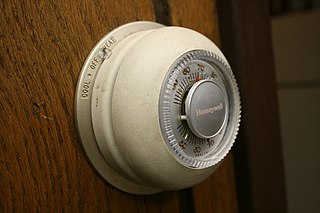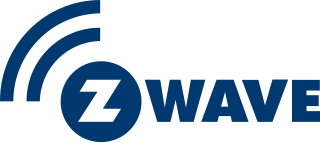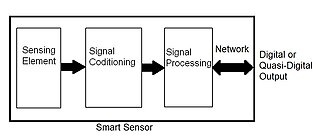Related Research Articles
Zigbee is an IEEE 802.15.4-based specification for a suite of high-level communication protocols used to create personal area networks with small, low-power digital radios, such as for home automation, medical device data collection, and other low-power low-bandwidth needs, designed for small scale projects which need wireless connection. Hence, Zigbee is a low-power, low data rate, and close proximity wireless ad hoc network.

A thermostat is a regulating device component which senses the temperature of a physical system and performs actions so that the system's temperature is maintained near a desired setpoint.
Over-the-air programming refers to various methods of distributing new software, configuration settings, and even updating encryption keys to devices like mobile phones, set-top boxes, electric cars or secure voice communication equipment. One important feature of OTA is that one central location can send an update to all the users, who are unable to refuse, defeat, or alter that update, and that the update applies immediately to everyone on the channel. A user could 'refuse' OTA, but the 'channel manager' could also 'kick them off' the channel automatically.

Z-Wave is a wireless communications protocol used primarily for home automation. It is a mesh network using low-energy radio waves to communicate from appliance to appliance, allowing for wireless control of residential appliances and other devices, such as lighting control, security systems, thermostats, windows, locks, swimming pools, and garage door openers. Like other protocols and systems aimed at the home and office automation market, a Z-Wave system can be controlled via the Internet from a smart phone, tablet, or computer, and locally through a smart speaker, wireless keyfob, or wall-mounted panel with a Z-Wave gateway or central control device serving as both the hub controller and portal to the outside. Z-Wave provides the application layer interoperability between home control systems of different manufacturers that are a part of its alliance. There are a growing number of interoperable Z-Wave products; over 1,700 in 2017, and over 2,600 by 2019.

Building automation is the automatic centralized control of a building's HVAC, electrical, lighting, shading, Access Control, Security Systems, and other interrelated systems through a Building Management System (BMS) or Building Automation System (BAS). The objectives of building automation are improved occupant comfort, efficient operation of building systems, reduction in energy consumption, reduced operating and maintaining costs, increased security, historical performance documentation, remote access/control/operation, and improved life cycle of equipment and related utilities.

A home network or home area network (HAN) is a type of computer network that facilitates communication among devices within the close vicinity of a home. Devices capable of participating in this network, for example, smart devices such as network printers and handheld mobile computers, often gain enhanced emergent capabilities through their ability to interact. These additional capabilities can be used to increase the quality of life inside the home in a variety of ways, such as automation of repetitive tasks, increased personal productivity, enhanced home security, and easier access to entertainment.

A smart transducer is an analog or digital transducer, actuator or sensor combined with a processing unit and a communication interface.
The Internet of things (IoT) describes physical objects that are embedded with sensors, processing ability, software, and other technologies that connect and exchange data with other devices and systems over the Internet or other communications networks.

Daintree Networks, Inc. is a building automation company that provides wireless control systems for commercial and industrial buildings. Commercial building control and lighting control systems can reduce energy consumption, cost, and carbon footprint, and comply with "green" building regulations.
The Internet Protocol for Smart Objects (IPSO) Alliance was an international technical standards organization promoting the Internet Protocol (IP) for what it calls "smart object" communications. The IPSO Alliance was a non-profit organization founded in 2008 with members from technology, communications and energy companies. The Alliance advocated for IP networked devices in energy, consumer, healthcare, and industrial uses. On 27 March 2018, the IPSO Alliance merged with the Open Mobile Alliance (OMA) to form OMA SpecWorks.
OpenTherm (OT) is a standard communications protocol used in central heating systems for the communication between a central heating boiler and a thermostatic controller. As a standard, OpenTherm is independent of any single manufacturer. A controller from manufacturer A can in principle be used to control a boiler from manufacturer B. However, OpenTherm controllers and boilers do not in fact always work properly together. The OpenTherm standard comprises a number of optional features and some devices may include manufacturer-specific features. The presence or absence of such features may impair compatibility with other OpenTherm devices.

Smart thermostats are Wi-Fi thermostats that can be used with home automation and are responsible for controlling a home's heating, ventilation, and air conditioning. They perform similar functions as a Programmable thermostat as they allow the user to control the temperature of their home throughout the day using a schedule, but also contain additional features, such as sensors and Wi-Fi connectivity, that improve upon the issues with programmable thermostats.

Google Nest is a line of smart home products including smart speakers, smart displays, streaming devices, thermostats, smoke detectors, routers and security systems including smart doorbells, cameras and smart locks.

GreenPeak Technologies was an Utrecht, Netherlands-based fabless company developing semiconductor products and software for the IEEE 802.15.4 and ZigBee wireless market segment. ZigBee technology is used for Smart Home data communications and to facilitate the Internet of Things, the term used to refer to devices designed to be operated and managed by internet-enabled controllers and management systems.

The Nest Thermostat is a smart thermostat developed by Nest Labs and designed by Tony Fadell, Ben Filson, and Fred Bould. It is an electronic, programmable, and self-learning Wi-Fi-enabled thermostat that optimizes heating and cooling of homes and businesses to conserve energy.
HomeSeer Technologies LLC is a technology company based in Bedford, New Hampshire, in the United States. HomeSeer makes home automation controllers and software, designed to integrate lighting, HVAC, security, AV and other subsystems in most homes. Additionally, the company maintains an online store of compatible home automation products and a free online community forum for users and dealers.
Universal Electronics Inc. (UEI) is an American smart home technology provider and manufacturer of universal remote controls, IoT devices such as voice-enabled smart home hubs, smart thermostats, home sensors; as well as a white label digital assistant platform optimized for smart home applications, and other software and cloud services for device discovery, fingerprinting and interoperability. The company designs, develops, manufactures and ships products both under the "One For All" brand and as an OEM for other companies in the audio video, subscription broadcasting, connected home, tablet and smart phone markets. In 2015, it expanded its product and technology platform to include home automation, intelligent sensing and security.
Hive is a trademark owned by Centrica Hive Limited that produces smart home devices. It is one of the largest connected home providers in the UK and, as of May 2018, the company had more than 1,000,000 customers.
The industrial internet of things (IIoT) refers to interconnected sensors, instruments, and other devices networked together with computers' industrial applications, including manufacturing and energy management. This connectivity allows for data collection, exchange, and analysis, potentially facilitating improvements in productivity and efficiency as well as other economic benefits. The IIoT is an evolution of a distributed control system (DCS) that allows for a higher degree of automation by using cloud computing to refine and optimize the process controls.
The Internet of Military Things (IoMT) is a class of Internet of things for combat operations and warfare. It is a complex network of interconnected entities, or "things", in the military domain that continually communicate with each other to coordinate, learn, and interact with the physical environment to accomplish a broad range of activities in a more efficient and informed manner. The concept of IoMT is largely driven by the idea that future military battles will be dominated by machine intelligence and cyber warfare and will likely take place in urban environments. By creating a miniature ecosystem of smart technology capable of distilling sensory information and autonomously governing multiple tasks at once, the IoMT is conceptually designed to offload much of the physical and mental burden that warfighters encounter in a combat setting.
References
- Smart Home Digest What is a Sentroller
- Electronic Design Sentrollers in the Internet of Things
- ECN Magazine ZigBee opens up the Sentroller market for Smart Home device developers
- HomeToys Magazine After Big Data, it is now Small Data’s turn to change our world
- DesignWorld Designing with ZigBee - 3 things you need to know
- Senors Online The Rise of Sentrollers
- Braingrid Corporation's Sentroller